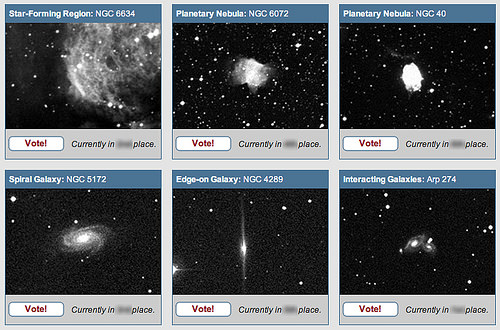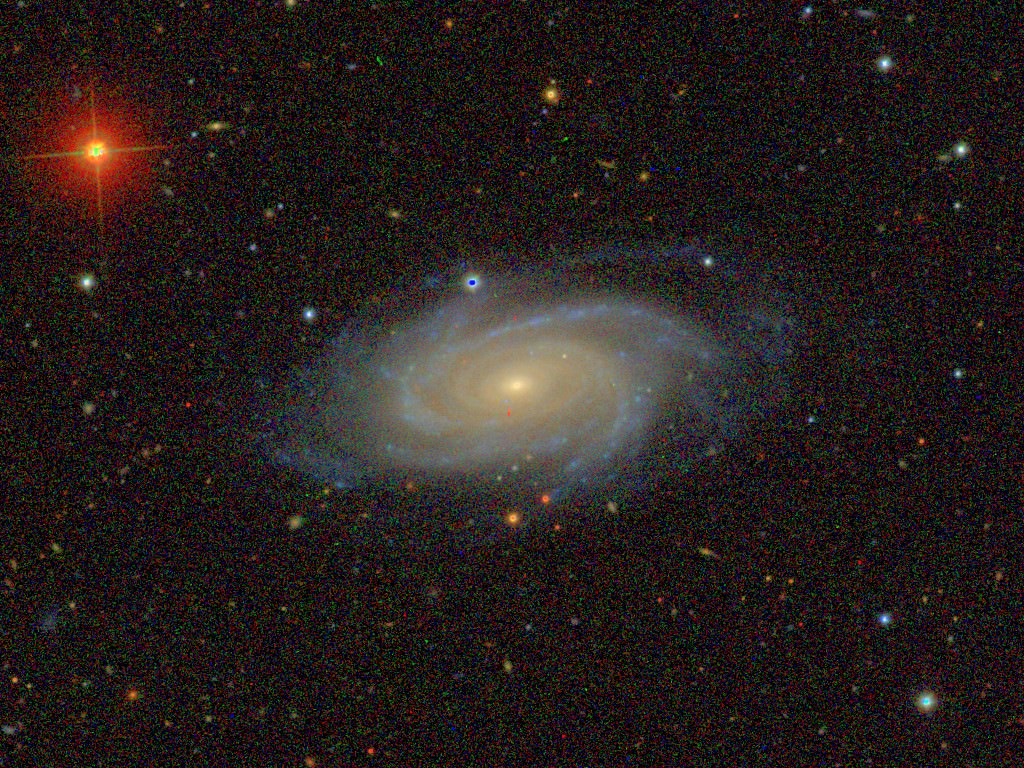[/caption]
The folks who run the Hubble Space Telescope have decided to ask for some help in choosing where to next point the world’s most famous telescope. People from around the planet can vote to select the next object the Hubble Space Telescope will view. The choices are six objects Hubble has never observed before. You can also enter a drawing to win one of 100 new Hubble pictures of the object that is chosen. The winning image will be released between April 2 and 5, during the IYA’s 100 Hours of Astronomy, a global astronomy event geared toward encouraging as many people as possible to experience the night sky. You need to vote by March 1 to swing Hubble toward your favorite target. So get over to the HubbleSite and vote!
The choices are two planetary nebulae (NGC 40 and NGC 6072), an emission nebula (NGC 6634), an edge-on spiral (NGC 4289), a spiral galaxy (NGC 5172 – seen above from the Sloan Digital Sky Survey) and interacting galaxies (Arp 274).

Here’s a screen shot of the HubbleSite page where the voting is taking place, with the rankings blurred out. (This image was stolen from Phil Plait’s Bad Astronomy site –thanks Phil!) But get over to the HubbleSite already and vote! If you need some more info to help you decide, there is a video with Dr. Frank Summers, a very fun astronomer-type guy who will explain each of the target objects. This event is part of the International Year of Astronomy (IYA), the celebration of the 400th anniversary of Galileo’s astronomical observations with his telescope.
Sources: HubbleSite, Bad Astronomy


THIS IS RIDICULOUS,THE HUBBLE SCIENTIST SHOULD STOP WASTING VALUABLE TIME & START SEARCHING SERIOUSLY FOR MORE SIGNS OF EXTRASOLAR PLANETS & OTHER PLANETS & PLANETOIDS IN THE OUTER PART OF OUR Earth-Sol system & the Oort Cloud.
Personally, I would like them to re-image the Alpha Centauri system. Hubble has not looked at it since 2003 from what I can tell, before it’s upgrade. As our closest neighbor, I would think we would want to know all we can about it.
I voted for NGC 5172 🙂
Well, I see some people still need to discover their caps lock..
Mr. S you obviously dont understand the benefit of education. We need to justify our science funding by educating the public, and inspiring them. Even on science grounds alone, these are excellent targets.
The photography of Hubble has, far and away, proven the most influential and popular in the history of Astronomy. What is that worth?
I am shocked that no one is voting for NGC 40. It would obviously be a stunning image, and as a target is just about the right size. I fear that the crappy image posted on the hubble page is turning people off. Anyone google NGC 40 and tell me that would not make a perfect hubble shot.
Mr. S Says:
January 28th, 2009 at 8:20 am
>>>Well, that is your opinion of what is important, but seeing as you don’t own the telescope, that doesn’t really matter does it?
Hubble is not a purpose built survey telescope either. It will waste huge amounts of valuable observing time returning nothing at all if it used to try to find outer solar-system objects – you can spend years snapping away only to find maybe one or two insignificant objects at best. There are telescopes on the ground more suitable for the job. There are plenty of other more purpose built scopes for extrasolar planet searches too.
Hubble is a valuable scientific instrument, but it’s power to capture the imagination of the public is invaluable, and you don’t need to be a genius to see why this is crucially important. Who can honestly say that seeing the ‘pillars of creation’ image for the first time wasn’t an awe-inspiring, nay, quasi-religious moment in their lives? Hubble images inspire many into astronomy – it has brought the majesty of the universe to those who knew nothing about it, yet can stare in wonder at such images and be moved to find out a little more. It is the ‘pretty pictures’ that achieve this end, not the esoteric scientific results or the discovery of a new one thousand Km diameter rock out past Pluto..
I voted for the Arp galaxy because Halton Arp is one of the few people who have a clue what is going on in the cosmos.
Not only an exercise in pretty pictures, but an opportunity for basic research … so I go for Arp 274 = NGC 5679,& NGC 5679C, (& NGC 5674A??), where star formation must be occurring in the galactic interaction, or more practically, where globular cluster formation is also probably happening, & GCs are more likely to be distinguishable at that distance, nie? Vive les Clustres Globulaires!!!
I think they should look for the Klingons near Uranus.